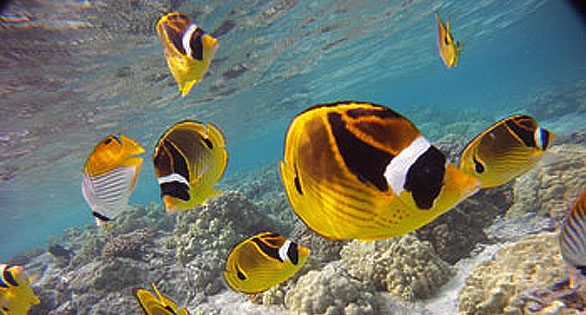
Butterflyfishes on the west coast of the Big Island of Hawaii where aquarium collectors are active. Image by Eric Sorensen, WSU.
An Aquarist’s Notes: Turbulence in Hawaii
I first went to Hawaii on assignment for CORAL Magazine in 2010, and for the better part of four years I have covered that state’s aquarium fishery. I expected to find a fishery full of complicated regulations and even more complicated conflict. I found the latter in spades, but the former, to my surprise, didn’t really exist. Regulations were relatively few and far between—no total allowable catches (TACs), no quotas, no bag limits, no limited entry. I was, quite frankly, shocked that a commercial fishery in U.S. waters would be so unregulated.
The fishers I interviewed, especially on Big Island, didn’t view it that way. Many felt they were being unfairly targeted and that veils of regulation were being drawn around them like the barrier nets they use to catch aquarium fishes. Some felt they had consistently given ground, made concessions in the face of anti-trade activism. Some were ready to make a stand, saying they couldn’t—wouldn’t—give any more.

Dr. William Walsh, strong proponent of new regulations to protect reef species—and the fishers who collect them.
Some of these fishers opposed the rules package just signed by the governor. A few of them still oppose it, although they are not willing to say so on the record. Those fishers who stand in opposition to the new rules have some strange bedfellows. There are the anti-trade activists who say the rules don’t go far enough; the most extreme will not be satisfied with anything short of a fishery closure. Then there are mainland aquarists who are lukewarm on the new rules. They worry that a White List will make it more difficult to acquire some species with which they want to work in the short term. They anticipate a slippery slope that will lead to fewer and fewer species remaining available to trade in the long run.
Personally, I was pleased to see the governor sign the rules package. I’m pleased because I see it as a step forward for aquarium fisheries in general. I see an opportunity to manage the fishery based on real data. The data really does matter, and rather than less, we need more. This rules package takes a relatively small swath of ocean—a shoreline of less than 150 miles—and says we’re going to manage it based on something more than anecdote and emotion. I look forward to reporting on the progress and talking about how this may be a model viable for export to other aquarium fisheries in far worse shape than Hawaii’s.
Hawaii is on a path of good, data-based, adaptive management of its aquarium fishery. This type of management can protect the fishery in terms of both environmental sustainability and economic value. It replaces a messy form of conflict resolution with a multi-stakeholder, community-based approach, and now that the new rules are law, I think we all owe it to the people, the process, and the potential to get behind them.





Trackbacks/Pingbacks